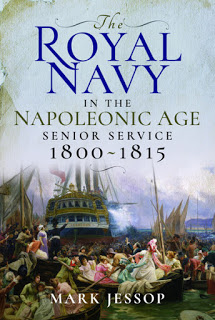
The Royal Navy in the Napoleonic Age : Senior Service 188-1815. By Mark Jessop. Pen & Sword History, Barnsley, 2019.
Reviewed by John Johnston
With more than 6.000 book titles in print, interest in the long wars against the French Republic and the Empire evidently remains unsated. More than 600 titles deal with the naval history of the Revolutionary and the Napoleonic Wars, and nearly 400 are devoted to the battle of Trafalgar.
Standing out in such a torrent of publications is a challenge for the historian, not least when the reading public’s perception of the French Wars is shaped by romance and the historical novel rather than accounts of events and analyses of statistics.
Almost a century ago, the Irish historian, Eileen Power faced a similar problem when she sought to reinvigorate interest in the Middle Ages. Power brought together source materials from the Middle Ages and wove them into a series of short stories which presented medieval people as real persons, with whose travails and pleasures readers could readily identify. Her book, Medieval People, caught the public imagination and remains in print to this day. Mark Jessop follows in that honourable tradition, taking the reader on a guided tour of the Royal Navy as it evolved between 1800 and 1815 through a sequence of fictional vignettes that recount the events and changes of those years as common people experienced them and which are contextualised in clearly, simply, and uncomplicatedly written essays.
The presentation of Trafalgar exemplifies Jessop’s tour. Three petty officers meet the sisters of a deceased friend and describe to them the terror, the stench, and the confusion of the unnamed but immediately recognisable battle in which he died. The short essay traces the sequence of events that led to the battle, places the battle into its strategic context, and details the costs of victory and defeat. A second vignette follows: a poet struggling to reconcile the triumph at Trafalgar with the heavy British losses suddenly realises that the unexpected victory has not only lifted the sense of national despair but that, in freeing England from the threat of invasion, it has also been a moment of national liberation. Jessop thus subtly brings together the tension between the human cost of Nelson’s triumph and the palpable relief which his success engendered.
The vignettes are collages, skilfully fabricated from contemporary newspapers, memoirs, parliamentary reports, and private correspondence. They are entirely credible, and one can imagine oneself overhearing the conversation between the petty officers and the sisters or sitting beside the poet as he struggles for inspiration. They bring the cold explanation and analysis of events, technological developments, and naval tactics in the essays to life, so that one moves seamlessly from one perspective to another in grasping the complex and multi-facetted character of England and its navy in the early nineteenth century.
Jessop’s thought-provoking study of how unremitting warfare affected people and society and spurred the development of new technologies and practices at sea is a homage to the pioneering works of Jeremy Black, Linda Colley, and Edward Thompson and a worthy continuance of Power’s idea of sparking the interest of the reading public through fiction. Anyone considering how to differentiate their exhibition or a publication from those of others will do well to look at this work, while the general reader will find it difficult to put the book down. Anyone who is seeking a Christmas present could do well to start here.



